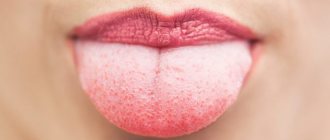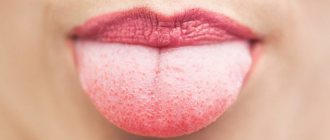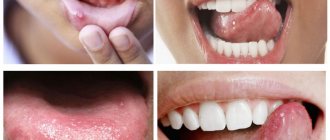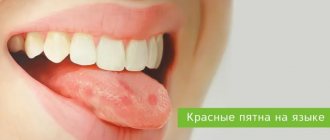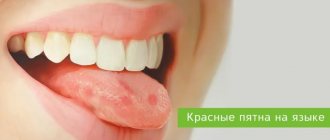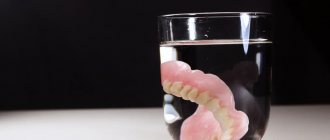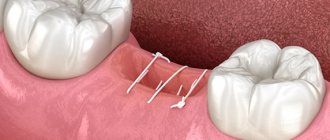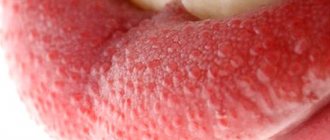When red bumps appear on the tongue, at the tip or closer to the throat, you need to find out what this phenomenon is. Such rashes often bother not only adults, but also children. And since they arise for a wide variety of reasons
, you need to figure out whether pimples pose a danger and choose the optimal treatment method.
Classification of pimples
There are many types of pimples on the tongue. They are classified according to four characteristics: color, location, size and pain.
Color
- Natural, red-pink.
Growths that do not differ in color from the tongue and are painless are warts or condylomas. - When red or bloody pimples
, such as in the photo, their cause may be a burn, herpes, or allergic reactions. - Red bumps that turn black
are associated with mechanical damage or injury. The black color appears due to microhemorrhage.
Location
- On the tip of the tongue.
Often this place is subject to injury and various damage, which can cause inflammation. First, a small bump appears on the end of the tongue, then a painful red or black pimple. - On the side.
In most cases, pimples are localized in this place, as a result of stomatitis, as well as benign neoplasms. - At the larynx.
Red pimples on the tongue closer to the throat often turn out to be benign formations: condylomas, warts. - Under the tongue.
Lumps and bumps in this place (near the frenulum) in both adults and children indicate inflammatory processes: tonsillitis, sore throat, pharyngitis.
The size of the formations can be large, medium or small.
Presence of pain
- Painful sensations.
Pimples resulting from injuries, burns, inflammatory and infectious lesions of the oral cavity and larynx. Pain manifests itself when touching the tubercles; it hurts a person to speak or swallow. - There is no pain.
In most cases, painlessness is characteristic of warts and condylomas. Benign neoplasms often affect the root of the tongue; you can see how it looks with pimples in the photo.
Special types of glossitis and their treatment
In addition to the above types of glossitis, dentists distinguish special types of glossitis, characterized by the development of limited specific changes in the tongue. These include:
Desquamative glossitis
It appears in the form of a “geographical” tongue, which has a “variegated” pinkish-red appearance, somewhat reminiscent of the outlines of the continents on a geographical map. In some cases, with the development of the inflammatory process, thinned areas cleared of plaque may change their position and shape within a short period of time (2 - 4 days). In such cases, desquamative glossitis is also called wandering glossitis. This can usually be observed with exudative diathesis, diseases of the digestive system, helminthic infestations, metabolic disorders, blood diseases, pregnant women, etc. Desquamative glossitis involves standard treatment, which leads to a gradual cleansing of the surface of the tongue and the disappearance of associated complaints in the patient.
Median rhomboid glossitis
It is characterized by the presence of a local thickening of the epithelium, usually located in the middle of the back of the tongue. In this case, the thickened area of the epithelium has a diamond-shaped or oval shape and can change its color from red to bluish. Rhomboid glossitis most often occurs in chronic diseases of the digestive system and is prone to chronicity and recurrence. Depending on the form of glossitis (flat, tuberculate, papillomatous), appropriate treatment is carried out: laser therapy, surgery, etc.
Atrophic glossitis
It often develops with insufficient intake of vitamins A and E. It usually appears as a single bright red, smooth spot that occupies the entire surface of the tongue. The focus of atrophy can persist for quite a long time without progressing. Sometimes the tongue decreases in size. Histological examination reveals dilation of blood and lymphatic vessels, swelling and inflammation in the papillary layer. Often, atrophic glossitis is a symptom of tongue damage due to gonorrhea.
Gunter's glossitis
Appears with a deficiency of vitamin B12 and folic acid. It most often occurs with blood diseases (usually anemia associated with impaired hematopoietic processes). In this form of the disease, the surface of the tongue is bright crimson in color and, due to atrophy of the papillae, has a “varnished” appearance. Gunter's glossitis involves treatment of the underlying disease by a therapist or hematologist.
Mycotic, candidal, or yeast glossitis
As a rule, it is a consequence of intensive antibacterial therapy, as a result of which the normal microflora in the patient’s body was suppressed. The disease manifests itself as swelling of the tongue, an accumulation of white plaque on it, with pronounced longitudinal and transverse grooves. Very often, mycotic glossitis occurs in young children and the elderly, as well as in people with weakened immune systems. Candidal glossitis requires treatment with antifungal drugs.
As an additional means for the treatment and prevention of glossitis, many experts have recently begun to recommend the use of an ultrasonic brush for oral hygiene.
Causes of pimples on the tongue
The main causes of rashes:
- Traumatic injuries, burns. It is not uncommon for the tip or side surface of the tongue to be damaged by cutlery, excessively hot food, or one’s own teeth.
- Weakened immunity. When pimples appear on the tongue closer to the throat, at its base or near the frenulum, this may indicate reduced immunity. A variety of pimples and bumps are localized here: condylomas and warts, candidal bumps.
- Development of benign and malignant tumors.
- Poor nutrition, bad habits. If you violate the rules of nutrition, excessive consumption of spicy, hot, rough foods, an irritating and traumatic effect on the mucous membrane occurs, which provokes the appearance of pimples. Excessive smoking and alcoholic libations also cause diseases of the mucous membranes in adults.
- The causes of lumps at the end and root of the tongue may be allergic. Allergic disease manifests itself not only on the skin, but also on mucous membranes.
Large bumps located close to the pharynx make it difficult to swallow food and can lead to breathing blockage.
- If pimples appear on the tongue closer to the larynx, they could be caused by various diseases of a chronic, viral and infectious nature.
- Neglect of hygiene rules. Eating unwashed foods and irregular oral hygiene not only in children, but also in adults, causes irritation of the mucous membrane and, as a result, the appearance of inflamed pimples.
Red bumps on the tongue closer to the throat - what are they?
In most cases, bumps at the base of the tongue, pimples on the side, growths on the tip of the tongue are manifestations of the following diseases:
- Diseases of the mucous membrane of an inflammatory nature (glossitis) are accompanied by the formation of painful red rashes on the mucous membrane, in severe form - abscesses, phlegmons.
- Metabolic disorders, vitamin deficiency. Such conditions are characterized by redness and enlargement of the taste buds, which often become inflamed and acquire a red-white color.
- Herpes, characterized by the appearance of painful red pimples and blisters.
If red bumps or nodules appear on the base of the tongue, this may be a symptom of pyogenic granuloma. The formations consist of blood vessels and are localized in the wounded area. Pathology occurs due to injuries and damage to the mucous membrane. When touching the formations, a person feels a sharp pain.
- Digestive disorders (malabsorption). Pimples on the root, all over the surface of the tongue, are one of the symptoms of this pathology.
- Candidiasis (thrush). A disease that often affects newborns. The child's tongue becomes covered with red bumps and a cheesy coating forms. The baby behaves restlessly, cries, and has difficulty swallowing; these symptoms are caused by itchy red-white pimples and dry mouth.
- HPV – human papillomavirus. Formations are localized in any area of the tongue: at the tip, root, side. The bumps on the tongue closer to the larynx cause particular discomfort, as they interfere with swallowing and create the sensation of a foreign object in the mouth.
- Allergic diseases. The rashes do not hurt, but they interfere with swallowing and speaking.
- Diseases common to children: chickenpox, measles.
What is this problem?
Red pimples and pimples on the tongue are formed due to enlargement of the papillae. Hypertrophy and redness of the latter occurs as a result of tissue desquamation .
If the mucous membrane of the tongue is covered with plaque and red pimples, then you should not put off visiting a doctor, otherwise the problem may become serious.
The first step is to find out in which area the pimple has formed, because the tongue is a suitable place for the growth of most bacteria.
In order to visually detect the inflamed area, the simplest method is suitable: carefully examine this muscular organ for the appearance of red pimples.
Several foci of inflammation can be detected at once, for example, red or white pimples may appear on the surface of the tongue, and each of them has its own cause and etiology.
Treatment of pimples on the tongue
Carrying out an examination of the mucous membrane of the tip, side, and root of the tongue, the doctor examines the red pimples and growths. Based on laboratory tests, examination and medical history, the specialist makes a diagnosis, finds out why the disease appeared, and determines the therapeutic direction. The classic method of treatment is medication:
- Antibiotics are used to destroy bacteriological pathogens
. Effective drugs for local action: Bioparox, Fuzafyungin. As well as medications for systemic treatment: Amoxicillin, Cefadroxil. - To prevent the rashes from becoming inflamed, anti-inflammatory drugs are prescribed: Stomatidin, Ingalipt, Lugol.
- Antiseptic agents accelerate wound healing: Chlorhexidine (it is necessary to apply lotions and rinses).
- Dysbacteriosis, which can cause rashes on the mucous membranes, is treated with probiotics: Bifidumbacterin, Acipol, Linex, Bifiform.
- If pimples appear on a baby's tongue, they are often caused by fungal infections; thrush is treated with antifungal drugs
. It is worth doing daily rubbing of the tongue, cheeks and lips with a broad-spectrum solution of Candide. After just 1–2 days, less plaque forms, and after a week, the signs of the disease completely disappear. - Allergic reactions are eliminated with the help of antihistamines: Fenistil, Cetrin, Erius.
How to carry out treatment?
How to treat inflammation on the tongue? What will help remove painful acne that causes a lot of inconvenience? If the red pimples are caused by an illness and home conditions do not allow it to be diagnosed, then it is best to see a dentist or otolaryngologist .
The specialist will conduct the necessary laboratory tests and identify the cause of the disease.
For treatment, the patient may be prescribed medications such as pyridoxine, fungizone, monistat, nystatin. You should be careful and not forget that self-medication usually does not give the desired result, and sometimes aggravates the process.
Recommendations that will help alleviate the patient’s condition until medical help:
- Try not to injure the irritated oral cavity.
- Do not overuse coffee or hot tea.
- Quit smoking and do not drink alcoholic beverages
- Avoid too hot foods, eat spicy and salty foods as little as possible, limit the amount of sugar and seasonings.
- Rinse the mouth with antiseptic solutions, potassium permanganate, chlorhexidine. You can use traditional medicine recipes and rinse your mouth with infusions of medicinal plants: chamomile, calendula, sage. Carry out the procedure before going to bed and after waking up, as well as after eating.
- A fungal infection, as the cause of the appearance of red pimples on the tongue, can be eliminated by rinsing with a soda solution or some antifungal drug, for example, nystatin.
- If the cause of the formation of blisters lies in a viral or bacterial infection, then self-treatment can harm the patient, so you can only relieve unpleasant symptoms by rinsing and drinking plenty of fluids.
Situations that should force a patient to seek medical help:
- If, in parallel with the appearance of pimples on the tongue, red spots and pimples appear on the body
- Body temperature rises.
- The pimples itch and begin to hurt, causing discomfort.
- There is swelling of the gums, lips or palate.
After examining the patient, the doctor may prescribe:
- For allergic genesis of pimples on the tongue, it is recommended to take antihistamines
- Antiseptics are prescribed to speed up wound healing
- Probiotics are prescribed to eliminate dysbiosis
- Antibiotics and anti-inflammatory drugs to destroy bacteriological pathogens.
Pimples appeared on the tongue: treatment at home
Having determined the nature of the rash, the doctor can prescribe a comprehensive treatment of the disease (drug and herbal treatment) or non-drug treatment at home. Pimples on the root, tip, and near the frenulum of the tongue can be removed using folk remedies.
Herbal medicine
Herbal decoctions and infusions effectively remove pimples both on the tip and at the base of the tongue. The most effective rinses are chamomile, St. John's wort, and calendula. Herbal decoctions are especially effective when the rashes are inflamed.
Method for preparing the decoction: pour a teaspoon of herbs into a glass of boiling water, leave for about 15 minutes, and cool. You need to rinse your mouth 2-4 times a day.
Infusions and decoctions can be taken orally, this will help alleviate the symptoms of the disease, relieve inflammation, and help stabilize metabolic processes.
Compresses and lotions
If the formations are inflamed, pain and inflammation can be relieved by applying a cotton swab moistened with a herbal decoction of chamomile and calendula to the affected surface.
You can numb the surface of the tongue using therapeutic and prophylactic toothpaste, which is applied for 2 minutes. The paste relieves pain, has a calming, anti-edematous and anti-inflammatory effect.
Rinsing with antiseptic solutions
They help treat inflammation of the mucous membrane, eliminate tubercles on the tongue both at the very beginning and closer to the throat. In the fight against the disease, the use of Chlorophyllipt and Chlorhexidine is common. The preparations can be used as rinses and are effective for irrigating the oral cavity. Procedures are carried out several times a day.
Home and folk remedies and methods
Depending on other associated symptoms in the mouth and throat, recommendations can be made to eliminate them.
Regular oral cleaning
Suffering from any kind of tongue problem cannot justify stopping the practice of hygiene procedures. On the contrary, regular cleaning of the oral cavity is even more necessary to fight microorganisms that accumulate there. Proper brushing will also help end bad breath.
Remedies for ulcers and wounds
Mouth ulcers are accompanied by pain. Therefore, hot and spicy foods should be avoided. Most meals for people with this problem should consist of liquid foods and drinks until the sores improve or are completely healed. Some of the tools will be useful to apply:
- Clove or coconut oil for applying to sores.
- A solution of aloe juice and honey for periodic mouth rinsing.
- A sage solution to rinse your mouth with once a day.
A warm saline solution can be used to relieve pain, but salt should not be placed directly on the sores. If this does not help, then you need to see a doctor so that he can prescribe a pain reliever.
Preventive measures
Simple preventative measures will prevent the onset of the disease. Basic rules of behavior and hygiene:
- Fruits and vegetables should always be washed before consumption.
- Food should not be excessively hot, cold, spicy or rough.
- The chewing process should be slow, which will prevent tongue biting.
- Personal hygiene should be observed: dental and oral care.
- It is necessary to have individual cutlery and a toothbrush.
- The brush should be renewed monthly. Change immediately after an illness.
- Regular visits to the dentist are recommended. It is necessary to treat diseases of the teeth and oral cavity in a timely manner, remove tartar and plaque, because these are the main sources of infection in the mouth.
- It is necessary to maintain adequate physical activity, which will increase immunity and the condition of the entire body.
Any pimple, growth or tubercle on the mucous membrane, both in an adult and in a child, requires close attention. You should not treat the bumps yourself; only a doctor can do this.
You should not pierce or try to squeeze out pimples on the mucous membrane; such actions can lead to negative consequences: the growth of foci of inflammation, the appearance of open wounds as a result of injuries.
The best thing a person can do if they have bumps on their tongue is to see a dentist or therapist. Such a decision will speed up recovery and prevent possible complications.
